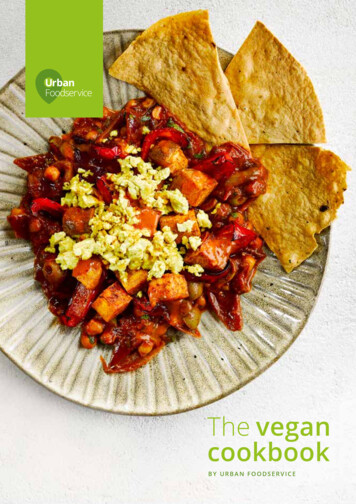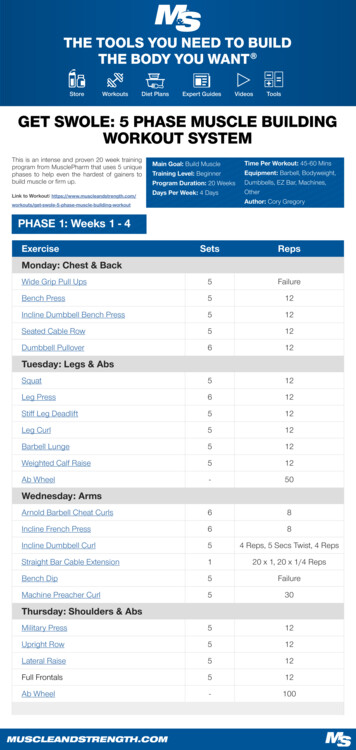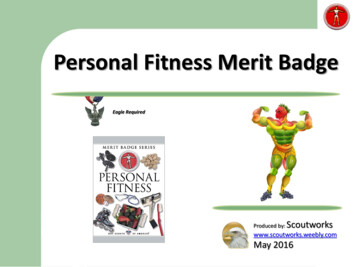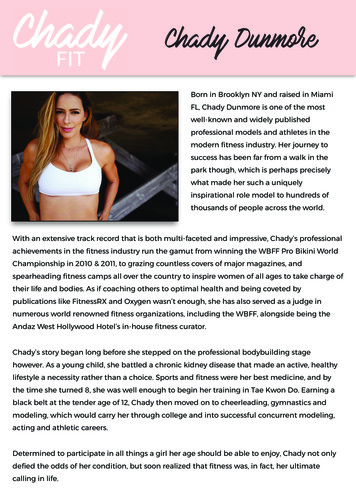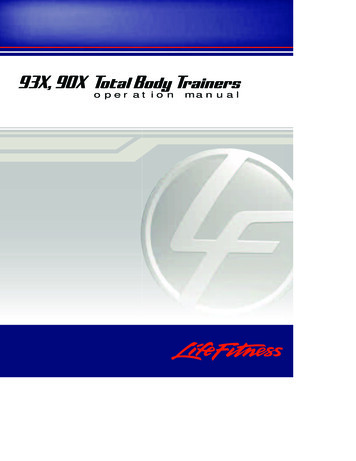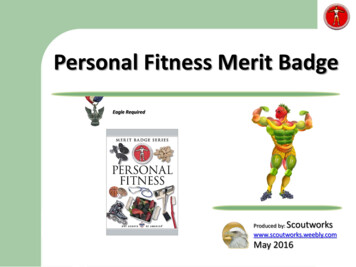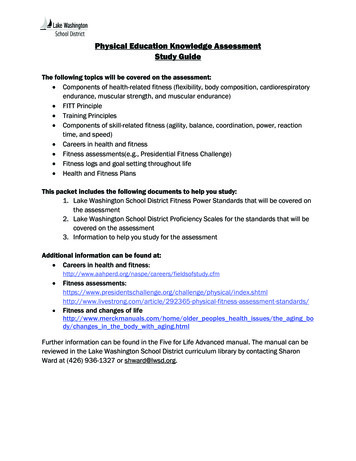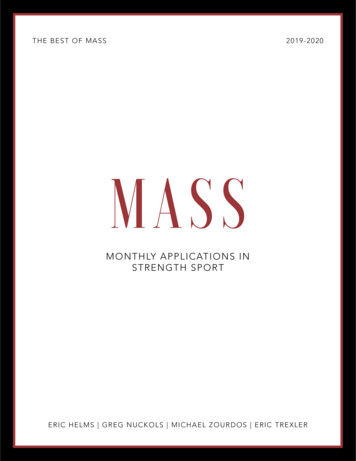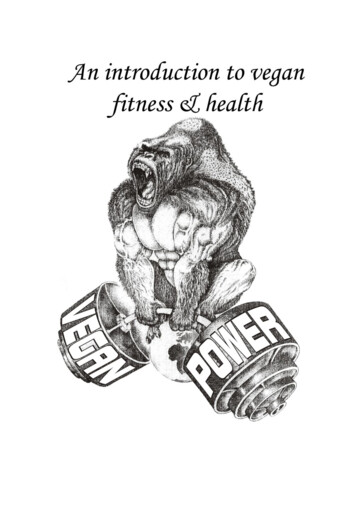
Transcription
PrefaceI cannot claim that this booklet is my own work! All of theinformation you’ll find in here is the accumulation of knowledgeI’ve gathered from the people that have helped me in my quest tofind the very best training and dietary information for athleteswanting to achieve their very best in performance. The journeystarted with one page I added on an animal rights website. I hadno idea there were any other vegans actually training, so the pagewas as much a search for others as a resource for people to use.This grew into the website www.veganbodybuilding.org as I metfriends & mentors who helped me on my journey to finding greaterfitness & health. Robbie Hazeley (the original ‘Vegan Bodybuilder’)taught me a lot about training and programming, Pat Reeves(World Record holding powerlifter) taught me much aboutnutrition and overcoming adversity; Joni Purmonen was my first‘virtual training partner’ as we both met on the old vegan poweryahoo group (now defunct) and we went on to grow first the VeganBodybuilding yahoo group, then launch the Vegan Fitness forumfrom that. Over the years we’ve seen the strength & fitnesscommunity change.In the beginning it was frowned upon to even consider droppingmeat, nowadays we have many of the top athletes moving towardsa vegan diet to improve their performance! With the increase inresearch backing up the vegan diet as both being super for healthand great for maximum performance we are now in position to saythat any athlete, in any sport, can benefit from moving towards aplant-based eating programme if they are after the best results fortheir effort and a healthier life generally.Special thanks must go to Paul Crouch of the Vegan Society and JaySherman for proof-reading. Also Kay Johns for both reading thisand taking many of the photographs used in this publication, aswell as everyone else who has helped me learn about training, dietand recovery, or helped on this booklet by allowing their photos tobe included - thanks everyone!Pete2
ContentsPreface 2Getting Started 5What the programme isn’t 6Who is the Captain? 6Simple, not Easy 7Beginning the Journey 8Goal Choices 9Going Healthy Plant-Based 9Hypothetical Jim 11Vegan Planning (don't get caught short!) 13The Big Three Dietary Systems 15Calories for Maintenance, Diet or Gaining 16Veganism & protein 16Vitamin B12 17Iodine 17EFAs (Essential Fatty Acids) 18Vitamins and Minerals 18Other foods 19When to eat 19Important Points when Beginning Plant-Based Eating 20o Losing Fat 20o Gaining Muscle 23o Maintaining 26Planning your Meals 27What to Eat 29Beans 29Frying and oil 30A few meals 30o Protein muffins 31o Millet slice 32o Pear and watercress soup 34o Scrambled Tofu 35o Tempeh Wraps 36Different eating options 37o Whole food vegan 38o Living Food 38o 80:10:10 38o Forks over knives/Engine2 38o Ornish diet 38o Fuhrman diet 383
o Eco-Atkins diet 38o Raw food 39Women Lifting 40Warming-up, Recovery and Other Factors 41Training 42Bodyweight training 42o Push-ups 42o Inverted Row 43o Wall Squat 43o Plank 44o Side Plank 44o Shoulder Bridge 45Beginners Training with Weights (written by strongman Joni Purmonen) 45The big 3 of getting big 45Train Hard 45Training Routine 46Sample Programmes 47o Back to basics routines 47o Whole body workouts 47o Another 3 day split 49Cardio training 50o Resting Heart Rate (RHR) 50o Ambient Heart Rate (AHR) 50o Delta Heart Rate (DHR) 51o Maximum Heart Rate (MHR) 51o Target Heart Rate (THR) 51o Recovery Heart Rate (ReHR) 51Edwards Age and Weight Predicted Method of Finding MHR 52Robergs and Landwehr Age Predicted Method of Finding MHR 52Age Predicted Method of Finding MHR 52o Zone 1 (healthy heart zone) 52o Zone 2 (fat burning zone) 52o Zone 3 (aerobic zone) 52o Zone 4 (anaerobic threshold) 53o Zone 5 (Red line zone) 53Steady State cardio 53HIIT (High Intensity Interval Training) 54Cardio weight training 55Resources 57Wrapping up 574
Getting startedNo, not the monolith from 2001 – it’s the dawn of the fitter you!So, you are one of four things right now: a meat-eater orvegetarian considering moving more plant-based, a veganconsidering starting to train, a vegan trainee who wants to improveyour results in the gym or a combination of some of the above.Really, it doesn’t matter which as whatever your goals, this bookshould be of some help in you finding the right plan.So, let’s get on with the outline of how I structure your training,eating and recovery. This is not the only way, there are many plansout there. A common saying is, “The perfect plan is the one you’llstick to!” That is very much the case with this programme. If youstick to it you will get better results than if you don’t. It may not bethe perfect plan for you, over time you’ll probably try out variouseating, training and recovery options, but I’m confident that many5
of the ideas outlined here will give you amazing results providingyou stick to them.What this Programme isn’tThis programme is not a diet, nor is it a training plan. It will provideyou with both, but its real strength is the fact that it is a lifestylechange. You are moving from what you are doing now to a newway of eating, training and recovering. It is not a quick fix or ashort term thing; to achieve and keep getting results you have tostay with the programme. You don’t do it for June, then it is done.The work is never truly done. In life you have two choices, to moveforward or to stagnate. Those are the options before you. Inreading this I am hoping you are beginning a journey of change thatwill strengthen you both physically and mentally. A voyage to abetter you!Who is the Captain?First off we have one very important decision to make before wecan embark on our journey. I have a question, “Who is theCaptain?” You don’t understand the question quite yet, but let meexplain a little. You have a goal, right? It could be fat loss, musclegain, or dietary change. It doesn’t matter really, the one questionyou must answer is, WHY are you doing it? Are you deciding togain muscle or is someone else deciding that you should have moremuscle, are you deciding to lose fat or is it the people at your officetalking fat and sniggering, that are making you want to lose fat?Your first job, before we start is to decide it is YOU wanting to makeany change, not some peer pressure, or what you ought to do, orfor a partner, or some other reason. These are NOT answers. Ifthese are your reasons for getting this product, then you are notthe commander of your own body. You must consider now exactlywhat you want. Forget the partner. Forget the peers. What do youwant? This is vital to know. If you start towards a goal that you donot really want, then you are unlikely to reach that goal. Pick a goalthat you truly desire, then aim yourself at that goal and you will bemuch more likely to succeed. If you want to be lean, then aim at6
leanness. If you want to look like a freaky large muscle type, thenaim at that. If you just want to tone-up for the beach, then aim atthat goal. I can guarantee that any goal you are after will be muchmore easily reached if it is something you truly desire and notsomething others wish you could achieve.Simple, not EasyMike shows you a simple movement that is certainly not easy to doIn this book you will find a lot of the information will be simple.That is because much of the research into diet, training andrecovery is simple. Do not be deceived though. ‘Simple’ does notmean ‘easy’! For those overweight people who wish to diet, theadvice will be hard to follow at times. For people beginning to train,it can be tough. Not because the advice itself is complex to do, butthat the actions are actually hard as your habits are still telling youto eat the cake, or go to the pub, or just forget the gym for tonight.So, although many of the actions will look simple, and are in factnot complex, actually doing them will be a tough at times. So beprepared for some hard times, especially if you have friends whoaren’t travelling a similar path. So simple does not translate to easyat all.7
Beginning the JourneyCerys shows you that it is never too early for a vegan to start trainingThe first task in any journey is to find out where you are right now.This will be the least pleasant part of this programme, but it isimportant! Find yourself a digital camera and take a few snaps ofyourself. Front, side and back is good. This gives you a startingpoint. Whether you are too thin, carrying too much fat or justlacking in tone, don’t try to disguise your flaws. You never need toshow these pictures to anyone. As the weeks progress you may notnotice a change yourself, but looking back at the photos cansometimes be a revelation. If you are really concerned, cut off thehead of the picture so you just see your body, if that helps. But getthe shots done, then pack them away for a later date. Scales don’tmatter, but as a record it might be a good idea to weigh yourselfand measure your waist. If you have any goals like certain sizebiceps in your arms or bigger leg muscles, then measure those aswell.8
Now that that is out of the way, let us get down to getting on theprogramme.Goal ChoicesWe’re going to start by splitting your goals into three so you canmake more sense and jump to the one you’re interested in rightnow. So, you’ll have a choice of “Going plant-based”, “Losing fat”,or “Gaining muscle”. We’ll also have a bonus section on womenlifting later on. I suggest you read them all as a vegan may stillneed to tweak their diet and someone considering fat loss may stillneed to add muscle.So, without further ado, let’s get started.Going Healthy Plant-BasedFractal cauliflower looks awesome!This will actually be the hardest of the choices. It could be harderdepending upon where you actually live. If you are surrounded byeateries that sell vegan foods, then the transition could be easier.But if you live in a place where people do not even know what theword ‘vegan’ means, then you could be in for a more difficulttransition.There is also another group who could benefit from this method ofdietary change: that is the vegan who has decided to make thechange to a healthier lifestyle. You will find that they tooexperience many of the problems and temptations that meat-9
eaters go through. There is something of a parallel between themeat-eaters feeling of loss of some foods they enjoyed and thejunk-food vegans loss at the removal of foods they enjoyed. Soeither person can follow the method below & get results.The approach I tend to employ the most is the “Gradual Transition”model. Some people can happily dump every animal product in thebin and start from scratch on day one. But for most they have noidea what to eat and so dumping every animal product would meanyou had nothing but a few wilted cabbage leaves for tea! So, thefirst goal is to replace. To do this I would suggest you start withbreakfast as that is easiest. Find a plant-based breakfast. This canbe porridge, or a protein shake, or whole grain toast, or even followsome other cultures breakfast ideas like rice (or quinoa), sushimade with tofu ‘scrambled egg’ (see page 35 for that recipe). Pickwhatever you like as long as it is plant-based and fits in with yourgoals. While you are becoming accustomed to this, begin to lookinto getting some cookery books. In this booklet we are includingsome recipes, but they are only a sample. You have foods fromevery culture and every continent to choose from; from pear andwatercress soup (page 34) to protein muffins (page 31). You maybe considering going raw food or some similar sub-set of plantbased eating (see our list of vegan dietary variations page 37), but ifyou are coming from a meat-eating background I would suggestyou first take some time and discover the wonders of whole foodvegan cookery. From there if you wish to continue to another subgroup, you can always make that choice once you have transitionedsafely into a 100% plant-based lifestyle. So find a few cookbookswith some recipes you may enjoy and put aside an evening or two aweek as ‘experimental night’. Pick a day that isn’t normally overlystressful and you have a little time to play in the kitchen. At firstyou may take some time to find recipes you like. This is normal asyou have to accustom your taste buds to new flavours and newtextures. But you'll get there.There is one issue that can occur, especially if you are moving froma diet that is radically different, with more fibre and morenutritious foods. Vegans have different intestinal bacteria to thoseon other diets. There are actual studies looking into what is living inyour gut and while vegans have one type of bacteria living there,10
meat-eaters have totally different strains of bacteria colonisingtheir alimentary canal! So, if you suddenly hit the gut with amassive increase in beans, fibrous leafy vegetables and wholegrains, then the possibilities may not be that pleasant! The wayaround this is to transition slowly, and if you need to, take inprobiotics and digestive enzymes. For some people the transitionwill take longer than others, but eventually anyone can make thechange from even the worst diet to a healthy one without toomuch hassle. Of course if you have any questions there are manyresources where you can ask questions and get advice (See page 57for a list of online resources). But remember if you have seriousissues always seek out a nutritional expert for advice.Top athletes Dave & Matt enjoying the OlympicsHypothetical JimSo, as an example, let's look at a hypothetical person called Jim.Jim has lifted some weights for a while and has decided to makethe transition to a vegan diet. At the moment he consumes around11
3,500 Kcal per day split into five 'feeds' (three meals & two snacks).He also consumes a post-workout shake.Jim's First ChangesJim really isn't that sure where to begin, as he hasn't even reallyeaten meat-free before and most of his present meals revolvearound meat and dairy. So his first changes will have to be gradual.The easiest changes can be made to the post-workout shake andbreakfast. So a simple change can have his whey protein swappedwith pea or rice protein. And for breakfast Jim removes his eggsand bacon, and adds in porridge, toast or scrambled tofu. So, wealready have both breakfast and post-workout sorted for Jim!Now Jim, give that a little time and see how you do. With thesechanges Jim will have to see if he is heading towards his goal. AsJim's goal is to lift well and look fit he will keep an eye on his liftsand his fat levels. If the fat starts creeping up or the lifts startdropping he knows that he only has to tweak a bit more or less ofthe breakfast or post-workout shake and he'll be back on track. Soit's easy to control. Assuming Jim's lifting and body composition isdoing great, he may now begin to include even more plant-basedfoodstuffs. Jim invested in a couple of cookery books and spends anight or two every week experimenting with new meal ideas. Hehas also been busy on the internet searching out eateries thatserve vegan food locally. As he discovers meals he adds them to agrowing list of meals he likes and he is also checking out the placeslocally that serve vegan food. Again, the transition is slow and hemonitors the changes as he does not want to lose strength or hisphysical condition while he changes his diet. The other thing hehas done is begin to check out the online support structures thatare out there. Especially if he is making the transition alone, thiscan be a lonely time so having some online support is fantastic. It isalso good to know that people have done this before and haveprobably been through every issue you have as they have made thechange from meat-eater to vegan. Jim may come across otherissues if he is an ethical vegan (suppose he didn't change his dietfor health reasons, but because he became concerned aboutanimals being killed or exploited by humans). He suddenly mayfind that his lifting shoes, powerlifting belt, gloves and otherequipment are made from animal products. Thankfully, everything12
from weightlifting shoes to belts and beyond have veganalternatives available (another reason for going online as peoplehave already found these things for you!) So, now Jim has madethe changes and his lifts have improved and so has his bodycomposition. It's a win/win for Jim. He is not only caring foranimals, but he has also moved a step closer to his goals.Obviously Jim does not exist and you may not find the dietarychange quite as easy. I have left out all the issues, like when youeat out it can be hard to find suitable food or when you go for ameal with a meat eating friend or family member. There are 101ways in which small problems can crop up, so let's look at a fewways in which we can prepare for them.Vegan Planning (don't get caught short!)Austin with friends ready to hit the stage. He manages to competein both bodybuilding & ultra-endurance eating only plants!Some people will have to pre-prepare food. This can be annoying,but is vital if you do not have places locally you can eat out at or are13
travelling to strange places. Even if you have got places lined-up, Iwould still make sure you carry something with you in case ofdelay, for example, a small bar, a few nuts, that kind of thing. It isjust there if you get stuck somewhere or the place you are going isunexpectedly closed, or some similar disaster. The second tip ispre-planning: go on the internet, phone up places, find places thatdo the food you want. If you are invited out to a meal, phone theplace and explain that you are a vegan and ask what options theyhave. Most places will have simple things like salad and tofu if youask in advance. So it pays to check before you turn up at their door.Next up, let's look at things you should have to make sure you are100% healthy.Getting your nutrition right is one of the three things you have toachieve if you want to reach your strength goals (the other twobeing recovery & training). The fundamentals are really simple andmost people already know the basics: Don’t eat junkEat plenty of fresh fruit & vegetablesDrink plenty of waterIf you want to gain weight, eat slightly more than youneed to maintain your present weightIf you want to lose weight, eat slightly less than you needto maintain your present weight14
The Big Three Dietary SystemsAustin can outrun & out-pose most people on ANY diet – he is 100% plant-powered!There are three distinct types of diet that are used when training.Each, of course, can be sub-divided, but for our purposes thesethree basic systems will be looked at.What are the three basic systems?Your diet will vary if you are trying to diet, trying to grow or tryingto maintain your body weight.What do they have in common?All three systems rely on eating regular meals and consuming alarge quantity of water, eating mainly healthy food (not junk) andmonitoring your weight and your body-fat levels (remember youcan weigh MORE, but have less fat).15
1g/lbCalories/Kg3835Carbohydrates6g/Kg men11g/Kg wo2.7g/lb men5g/lb rotein1.6g/Kg0.73g/lbCalories/Kg52 44-52Carbohydrates8g/Kg3.6g/lbCalories/pound24 20-24Fat1.5g/Kg0.68g/lbVeganism & proteinRob has become one of the best arm-wrestlers on earth while eating a vegan diet16
Protein: - now there is a word you hear occasionally in thebodybuilding world! There are three main types of protein sourcesfor a vegan this is usually called the vegan protein pyramid:There are also specialist sources like yeast, algae and other lesserknown sources, but the bulk of your protein intake will probably bemade up of the three food types listed in the diagram above.Vitamin B12 (cobalamins): - It is not necessary to eat B12 every dayas the liver can store many years worth of the vitamin. Also thebody can to a great extent recycle the stores of the vitamin andincrease absorption when supplies are low. Although many peopleshow no signs of deficiency after years, this does not mean that thebody has adequate levels of B12. You could still be suffering fromelevated homocysteine levels. Of course, you cannot 'see' or feelhomocysteine levels, but this is a sign of possible deficiencynonetheless and may do significant harm to vegans. I recommendthat everyone eat fortified foods or take a supplement to insureadequate levels of B12. My views on B12 have changed due toongoing research. I used to believe that B12 could be obtainedfrom yeast products, edible seaweed, tempeh, miso, but now Ihave doubts, as the research is unclear whether these contain trueB12 or similar products called 'analogues' that chemically look liketo B12, but do not function as B12. Until more is known I suggesttaking B12 pills or eating fortified foods.Iodine: - Edible seaweed is the most reliable source of iodine. Thereis also iodine in vegetables and grains (the amount depends on17
where the crop was grown). On this note the reason that mostmeat and dairy products have iodine in them is the fact that theysupplement the animals. So you could say that you are eatingiodine pills one step removed.EFAs (Essential Fatty Acids):- Vegans tend to eat more omega-6EFAs than omega-3 EFAs. To combat this I suggest that everymorning you include a tablespoon or two of flax seeds, chia seeds,walnuts or hemp. With flax seeds you will have to grind thembefore use (I use a cheap coffee grinder), but the others can beeaten without anything being done to them first. I would alsolower my intake of omega-6 fatty acids. That is usually the oil foundin most processed foods. Often cutting down on processed foodwill automatically cut your intake of omega-6 EFAs. If you areconcerned because you have to give up fish oil, then you are inluck. These days there are DHA and EPA oils (the helpful oils in fish)that come from algae. As an extra benefit, as this oil is lower downthe food-chain, it is much less likely to be contaminated with heavymetals, PCBs and other toxins when compared to fish oil. Also, fishoil actually contains a considerable amount of saturated fat alongwith the DHA/EPA oils. These are not beneficial at all. So, you areactually paying for fats you do not wish to consume. With thealgae versions you get no saturated fats, just DHA/EPA oil, so it isactually a superior product.A multi is a good ‘insurance’ especially if you are dieting hardVitamins and Minerals:- I get every athlete I train onto a basicmulti-vitamin. It is probably not vital, but as insurance I believe it is18
something most of us should do. You also cover your B12 that wayand a multi-vitamin costs very little more than B12 alone, so whynot? There could be a few occasions when taking supplementsmay be of significant benefit. One is if you are suffering intestinaldistress. If you are having trouble digesting food, then it makessense just to get some nutritional help. The second is when you aretransitioning from one diet to another. As your diet changes andthe bacteria in your gut rushes to catch up with those changes, youmay have things like sudden increases in phytate or oxalate intake,for example. For people accustomed to eating these foods thebacteria in the gut evolves to render these things harmless, but forpeople new to this diet you could suffer a temporary dip in certainvitamins and minerals as the gut bacteria changes to suit the diet.The last common case for extra vitamins and minerals is duringillness, disease or injury. These are times where you may not beable to get enough through food alone.Other foods:- You must remember to eat plenty of fresh vegetablesand fruit everyday to get all your trace elements to allow growth.Of special significance is vitamin C due to the form of iron thatvegans consume as compared to meat eaters. Meat eaters get asource of iron called heme iron from meat. This form of iron ismuch easier to absorb than the non-heme iron found in vegetables.Eating a diet that is high in vitamin C increases the absorption ofnon-heme iron, as does citric acid and other fruit acids.When to EatI used to believe that you needed to eat six-eight ‘feeds’ a day(three or four meals & three or four snacks), but having workedwith smaller athletes you soon find that creating meals that are 200Kcal or so is way too limiting and research has come out recentlythat it is probably total daily intake that matters more than howoften you consume food. The old idea of ‘stoking the furnace’ byeating more often seems to be less likely than it was several yearsago. So eat towards your goals. This could be three times a day oras many as eight. The amount of total calories you need in a daywill determine how often you eat. Be sure to eat nutritious food,19
not junk. Always think the day before or that morning, "Do I needto make anything to take with me". One thing I once read waswhen you are preparing food always make a big pot full and freezesome in individual portions for later. When you haven't got time tocook this can be a lifesaver!One important point is to eat (or drink a shake) within 60-90minutes after exercise as your body needs nutrients at that timeand will grow much better if it is fed at that time.While we are on the subject: WATER. Water is so important that itcan't be over stressed. Drink a lot (I mean A LOT!) of it. We all do it,we go out and get thirsty half way to somewhere. Take some waterwherever you go. I used to set minimum intakes, but have sincefound that water needs vary greatly. The idea of drinking until theurine is fairly clear seems to be the best guideline when it comes towater consumption.Important Points when Beginning Plant-Based EatingWith a little planning and forethought it is easy to meet yourdietary needs as a vegan strength athlete. If you follow the basicsystem outlined above, train hard and organise your recovery plancorrectly, you can achieve fantastic gains in strength and/or size.Losing FatMike uses kettlebells & bodyweight training to achieve an amazing level of health20
So, let’s look more closely at each of the three phases talked aboutpreviously. To start off let’s look at losing fat. Losing fat seemsvery, very simple at first glance. You just eat less and you will loseweight. Rather like 1 1 2, you would expect that eating less lessfat. But as it turns out it can be somewhat harder than that for theperson trying to lose fat. People are very complex organisms andwith some people food plays more of a role than simply a source ofnutrients. For many people with fat issues food has an emotionalcontent that can cause the act of dieting to be much moretraumatic than it is for the average person. During their lifetimesome people link food to happiness, contentment and reward. Sodepriving them of those foods is seen as punishment orunhappiness. On top of this, consistent under eating also sets uphormonal responses that fairly quickly slow the metabolism. So youhave both physical and mental depression which can be acombination that very few people can fight. To overcome this issuethe best way to diet is to add in what I like to call “strategic refeeds”. Some people call these “cheat meals”. But I do not seethem as ‘cheating’, but as a planned part of any dietary plan. Onceor twice a week, on a planned day (that is important!), you have ameal of your choice. The only rules are that it has to be a highcalorie meal and it has to be something you actually have a desireto eat. Let’s take pizza as an example, there are now many veganpizzas available to buy. So let’s say that it’s Monday and you feelthat awesome looking pizza calling to you across the room from thefreezer. Now, if you knew pizza was never on the menu while youwere on this diet you might just crack and maybe not just eat thepizza, but the cookies, the vegan ice cream and everything else(well you failed, so you might as well fail big time!). So, in this caseyou then have to suffer not just the binge, but also the aftermathof guilt and regret that often follows a failure of epic proportions.Thankfully, we have an alternative to this catastrophe. In thesecond scenario you hear the call of the pizza, but you know youhave a strategic re-feed planned for Thursday. Now, you know youwill be having pizza, but it will be on Thursday. Not only that, but itis actually part of the plan and eating pizza will help you achieveyour fat loss goals! So you can look that pizza square in the eyes21
and say, “Maybe not now, but on Thursday you will be mine!”Most people can do that if they have healthy options at hand todistract them while the urge for less healthy food is upon them. Inthe second scenario you still get pizza, but you get no guilt and noregrets. Eating the pizza is still leading you directly towards yourgoal. You can feel good about consuming a yummy vegan pizza!Obviously you mustn’t forget training as to look good you need todevelop muscle tone as well as lose fat. But if you can managethose two things, you’ll be looking great fairly quickly.Let’s talk about a simple plan you can use everyday that will giveyou some idea of how your dinner plate should look. Theseversions of ‘the vegan plate’ were taught to me by World Recordholding powerlifting Pat Reeves as a way to simply organise adinner plate to get approximately the right amount of nutrients toachieve healthy fat loss.Below you’ll see a diagram of a plate. You will see a light greyportion that is a protein source, the dark grey portion is acarbohydrate source and the white portion is vegetables (focusedon green leafy vegetables).Notice that: one quarter of your meal should be a protein source(tofu, beans, seitan, fake meat or similar); one quarter of your mealshould be a carbohydrate source (quinoa, brown rice, potato,squash etc); half the plate should be made up of vegetables (mainlygreen
Bodybuilding yahoo group, then launch the Vegan Fitness forum . o Whole food vegan 38 o Living Food 38 . o Fuhrman diet 38 . 4 o Eco-Atkins diet 38 o Raw food 39 Women Lifting 40 Warming-up, Recovery and Other Factors 41 Training 42 Bodyweight tr
